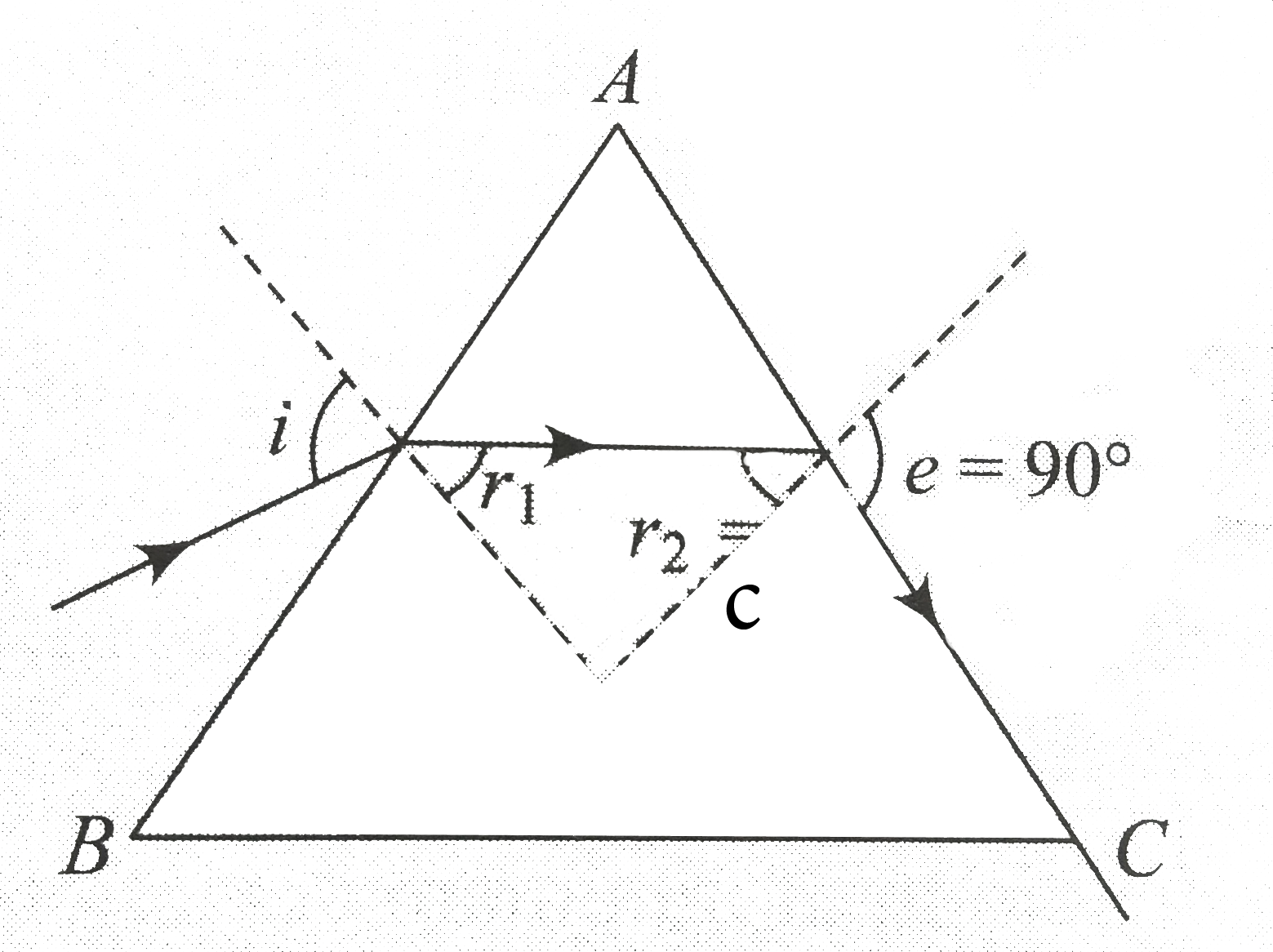The refractive index of the material of a prism of refracting angle 74∘ is 1.66 for a certain monochromatic ray. What should be the minimumangle of incidence of this ray on the prism so that no total internal reflection takes place as they come out of the prism.
To solve the problem of finding the minimum angle of incidence for a ray of light passing through a prism without experiencing total internal reflection, we can follow these steps:
Step 1: Understand the Problem
We are given:
- Refractive index of the prism material, μ=1.66
- Angle of the prism, A=74∘
We need to find the minimum angle of incidence, i, such that no total internal reflection occurs when the ray exits the prism.
Step 2: Identify the Critical Angle
The critical angle C for total internal reflection can be calculated using the formula:
sinC=1μ
Substituting the value of μ:
sinC=11.66
Calculating C:
C=sin−1(11.66)≈37∘
Step 3: Relate Angles in the Prism
When light enters the prism, it refracts at the first surface and then refracts again at the second surface. The angles of refraction at the two surfaces are related to the angle of the prism:
A=r1+r2
Where:
- r1 is the angle of refraction at the first surface.
- r2 is the angle of refraction at the second surface.
Given that A=74∘ and knowing that for minimum deviation, r1=r2, we can set:
r1=r2=r
Thus:
A=2r⟹r=A2=74∘2=37∘
Step 4: Apply Snell's Law
Using Snell's law at the first surface:
μ1sini=μ2sinr1
Where:
- μ1=1 (for air)
- μ2=1.66 (for the prism)
- r1=37∘
Substituting the values:
1⋅sini=1.66⋅sin(37∘)
Calculating sin(37∘):
sin(37∘)≈0.6018
Thus:
sini=1.66⋅0.6018≈1.000
Step 5: Solve for the Angle of Incidence
Since sini=1, we find:
i=sin−1(1)=90∘
Conclusion
The minimum angle of incidence i that ensures no total internal reflection occurs as the ray exits the prism is:
90∘
We are given:
- Refractive index of the prism material, μ=1.66
- Angle of the prism, A=74∘
The critical angle C for total internal reflection can be calculated using the formula:
sinC=1μ
Substituting the value of μ:
sinC=11.66
Calculating C:
C=sin−1(11.66)≈37∘
When light enters the prism, it refracts at the first surface and then refracts again at the second surface. The angles of refraction at the two surfaces are related to the angle of the prism:
A=r1+r2
Where:
- r1 is the angle of refraction at the first surface.
- r2 is the angle of refraction at the second surface.
r1=r2=r
Thus:
A=2r⟹r=A2=74∘2=37∘
Using Snell's law at the first surface:
μ1sini=μ2sinr1
Where:
- μ1=1 (for air)
- μ2=1.66 (for the prism)
- r1=37∘
1⋅sini=1.66⋅sin(37∘)
Calculating sin(37∘):
sin(37∘)≈0.6018
Thus:
sini=1.66⋅0.6018≈1.000
Since sini=1, we find:
i=sin−1(1)=90∘
The minimum angle of incidence i that ensures no total internal reflection occurs as the ray exits the prism is:
90∘
Similar Questions
The refractive index of the material of a prism of refracting angle 45∘ is 1.6 for a certain monochromatic ray. What will be the minimum angle of incidence of this ray on the prism so that no TIR takes place as the ray comes out of the prism.
View SolutionWhat should be the minimum value of refractive index of a prism, refracting angle A, so that there is no emergent ray irrespective of the angle of incidence?

View Solution
Knowledge Check
The critical angle for the material of a prism is 45∘ and its refractive angle is 30∘. A monochromatic ray goes out perpendicular to the surface of emergence from the prism. Then the angle of incidence on the prism will be
A60∘B75∘C45∘D30∘What should be the minimum value of refractive index of a prism of refractive angle A, so that there is no emergent ray irrespective of angle of incidence?
AsinA2BcosA2CcosecA2DsecA2What is the angle of incidence for an equilateral prism of refractive index √3 so that the ray si parallel to the base inside the prism?
A30∘B45∘C60∘DEither 30∘ or 60∘
A light rays is incident on a prism of prism angle A and refractive index μ. Show that the smallest value of the angle of incidence for which the reflected ray does not suffer total internal reflection at the second face, i.e. just comes out of it, is given by
i=sin−1[(μ2−1)1/2sinA−cosA].
View Solution(a) If the refracting angle of a prism is 60∘ and the minimum deviation is 30∘, then find the angle of incidence.
(b) A ray of light passes through an equilateral prism such that the angle of emergence is equal to the angle of incidence and each is equal to 3/4th of the angle of prism. Find the angle of deviation.
(c) The refracting of a prism is A and the refractive index of the material of the prism is cotA/2. Find the angle of deviation.
(d) The angle of a prism is 60∘. What is the angle of incidence for minimum deviation? The refractive index of the material of the prism is √2.
View SolutionA ray of light is incident at an angle of incidence 45∘ on an equilateral prism and emerge at an angle 45∘ then the refractive index of the medium of the prism is:
View SolutionA ray of monochromatic light is incident on one refracting face of a prism of refracting angle75∘ . It passes through the prism and is incident on the other face at the critical angle If the refracive index of the material of prism is √2, the angle of incidence on the first face o the prism is
View SolutionThere is an equilateral prism of material of refractive index 1.5. Light ray is incident normally on its surface. What will be the angle of deviation of ray ?
View Solution

